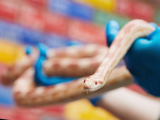Celebrating our Reptile Residents on World Reptile Day
21st Oct 2024
We just love how fascinating our reptiles are here at Battersea Park Children's Zoo and with it being World Reptile day TODAY, we thought we’d share some facts about some of our special reptile residents!
Barbie and Ken are our two panther chameleons. Because they prefer to live alone, you'll find them in separate habitats within our reptile house. These fascinating creatures can grow up to 51 cm long, with the males being larger and more vibrantly coloured than the females.
Our Chinese crocodile lizards are named after the dragons in ‘House of the Dragon’; Vermax, Caraxes and Vermithor! But don’t be fooled, the Chinese crocodile lizard isn't actually a crocodile or a dragon! But this solitary reptile does have a powerful, scaly tail that resembles that of a crocodile! Sadly, the Chinese crocodile lizards are an endangered species.
Our resident corn snake, Cornflake, loves to burrow or hide under logs and branches, but his bright orange colour makes him easy to spot. Cornflake is one of our longest-standing residents at the zoo, turning 18 years old this year! Incredibly, the average lifespan of this species is 14 years - so cornflake is an impressive age for his species, all thanks to the dedicated care of his zoo team.
Corn snakes can grow up to 1.5 meters long and when they feel threatened, they mimic the appearance and behaviour of a venomous copperhead snake! It's a clever trick that often scares away potential predators.
Guests participating in our Keeper Experiences often have the chance to meet Cornflake, a popular reptile who tends to win hearts!"
The eastern casque headed iguana, also known as the cone headed iguana, is a species found in the tropical rainforests of Central America.
At the zoo we care for two female iguanas, Maria and Valentina. Each iguana has a prominent crown adorning their head, and its body is a vibrant green, boldly accented with brown stripes that extend along its entire length, including its extraordinarily long, thin tail. This tail, in fact, can reach a length almost three times that of its body!
Unlike most reptiles who prefer a solitary life, Uki and Makira our Solomon Islands skinks live together in family groups called a "circulus."
Did you know that the solomon islands skink is a true relic of the past! It's considered one of the most ancient lizards on the planet and has remained virtually unchanged for millions of years!
The pancake tortoise is unique among tortoises, having an unusually thin, flat, and flexible shell. The pancake tortoise is listed as critically endangered, meaning they are on the edge of extinction. Their decline is mostly a result of intense harvesting for the exotic pet trade as well as habitat destruction. We are so proud to have had 2 hatchlings of this fragile species in less than 12 months at the zoo, as part of the European Endangered Species Programme. We now have 5 pancake tortoises living at the zoo! They can often be seen enjoying mealtimes together; eating flowers, grasses, spring greens and roots!
Another recent birth are 5 baby blue spiny lizards! Blue spiny lizards are a very interesting reptile as they are Ovoviviparous! This means that females give birth to live young, after the embryos develop inside eggs that remain in the mother’s body until they are ready to hatch!
Native to the rocky hillsides and scrublands of south Texas and northeastern Mexico, the babies grow up on a diet of fruit flies and hatchling crickets, until they’re big enough for larger insects!
For more information on all of our reptile residents check out our animal page and why not pay them a visit?
-
![]()
Ambilobe panther chameleon -
![]()
Original 271915D6 819F 46DC 97A4 E59FEEB3F8F8 -
![]()
Corn Snake -
![]()
Processed 98F1281A D896 4AFC ADBE BC87645C256E -
![]()
Original AABA240C 334B 4141 8D31 3C94B9DFC083 -
![]()
BPCZ Lowerres 09426 -
![]()
critically endangered pancake tortoise has hatched at the zoo (2) -
![]()
Blue spiny lizard (1) -
![]()
Image00003 -
![]()
Image00009

Sign up to our newsletter
Join our mailing list in order to keep up to date with Zoo news and special offers.











